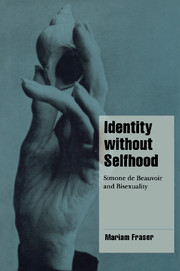Conclusion
Published online by Cambridge University Press: 27 October 2009
Summary
The theory of thought is like painting: it needs that revolution which took art from representation to abstraction. This is the aim of a theory of thought without image.
Gilles Deleuze, quoted in Paul Patton, ‘Anti-Platonism and art’In keeping with Foucault's genealogy, which examines not the history of the self but the historical processes by which the self comes to be established, I have outlined a number of techniques which serve to render the figure of de Beauvoir intelligible: individuality, narrative continuity, interiority, the ability to take responsibility for others as well as for oneself, materiality and visibility are among the techniques which have been explored here. Some of these techniques are understood, in a strict Foucauldian sense, to be practices through which the self establishes a particular relation to the self in the service of a desired state (such as authenticity). Others constitute the self through textually mediated narratives. Hence this study of bisexuality has illustrated not only how it is that bisexuality is produced through discourse, but also how the self itself is constituted and how the individuality ascribed to de Beauvoir is constructed. I have argued that it is precisely the production of de Beauvoir as an individual which precludes bisexuality from being produced as a property of the self. As it is constituted in the texts analysed here, bisexuality cannot be articulated in terms of ‘selfhood’ because in all manner of ways it exceeds the individuality conferred on de Beauvoir.
- Type
- Chapter
- Information
- Identity without SelfhoodSimone de Beauvoir and Bisexuality, pp. 164 - 170Publisher: Cambridge University PressPrint publication year: 1999

